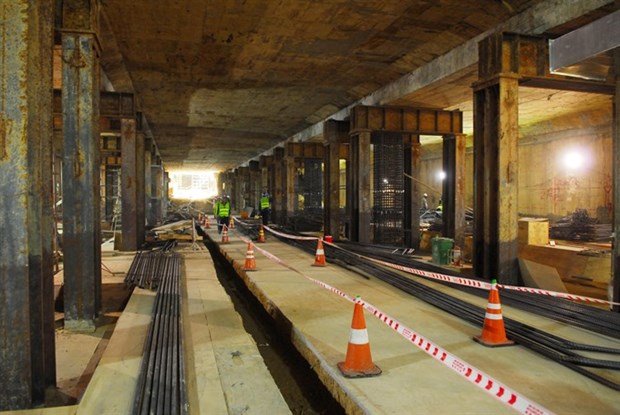HCM City metro to be linked with high-rises
HCM City’s Urban Railway Management Board has submitted a plan to link the urban railway system underground with high-rise buildings, apartments and shopping complexes.
 Workers at a construction site on the Ben Thanh – Suoi Tien metro route in HCM City (Photo: VNA)
Workers at a construction site on the Ben Thanh – Suoi Tien metro route in HCM City (Photo: VNA)HCM City (VNA) – HCM City’s Urban Railway Management Board has submitted a plan to the municipal People’s Committee to link the urban railway system underground with high-rise buildings, apartments and shopping complexes.
“The connections will bring huge benefits for the city, investors and local residents,” a representative of the management board was quoted as saying in the Tuoi Tre (Youth) newspaper.
HCM City’s Architecture Department said the city had agreed to the proposal to link the urban railway system with underground constructions.
“After the city opens its public underground space in Ben Thanh Metro Station and the metro, underground connections will be in high demand,” Nguyen Dinh Hung, deputy director of the Architecture Department, said.
“At first, the city will focus on mastering underground public spaces and encourage investors to link their construction with the metro system,” he added.
The No 1 metro line from Ben Thanh in District 1 to Suoi Tien in District 9 is the first project of an “underground master plan”, the first to be built in the country.
HCM City has asked the Prime Minister to agree to the use of ODA to build public underground works beneath Ben Thanh Trade Centre under Le Loi street.
The trade centre will have a length of 515 m and an area of 45,000 sq.m, with a total investment of 6.9 trillion VND (302 million USD).
The trade centre will also be connected to other trade centres and high-rise buildings downtown, especially those on Le Loi and Nguyen Hue streets and around Ben Thanh Market.
At the Ben Thanh metro station, six exits will be built to help receive customers and passengers from roads to the underground space.
The management board said that all eight metro lines should be built as underground stations along with shopping centres, as a way to effectively use capital.
“The local government should announce the specific positions of underground metro stations. This will help attract investors willing to build underground trade centres,” an official from the management board said.
“The city has instructed the Architecture Department to complete the underground master plan. This is one solution to ease traffic congestion,” Hung said.
The Architecture Department has excluded underground construction of houses, schools, hospitals, hotels, dormitories, theaters, exhibitions and stores.
"Right now, the master plan for underground space has become urgent. The Department will focus on downtown first, and then expand to the whole city,” Hung said.
Meanwhile, the Transport Department plans to build 18 underground parking plots due to lack of land. Construction has begun on four of the lots.
Many investors have suggested building both parking plots and trade centres underground. Most of them plan to use 30 – 50 percent of the parking plot areas as sites for shopping centres.
For example, at an underground parking plot in Le Van Tam Park, four floors for parking will be built with 1,260 cars, 2,000 motorbikes, and three underground shopping floors with a total area of 33,000 sq.m.-VNA












